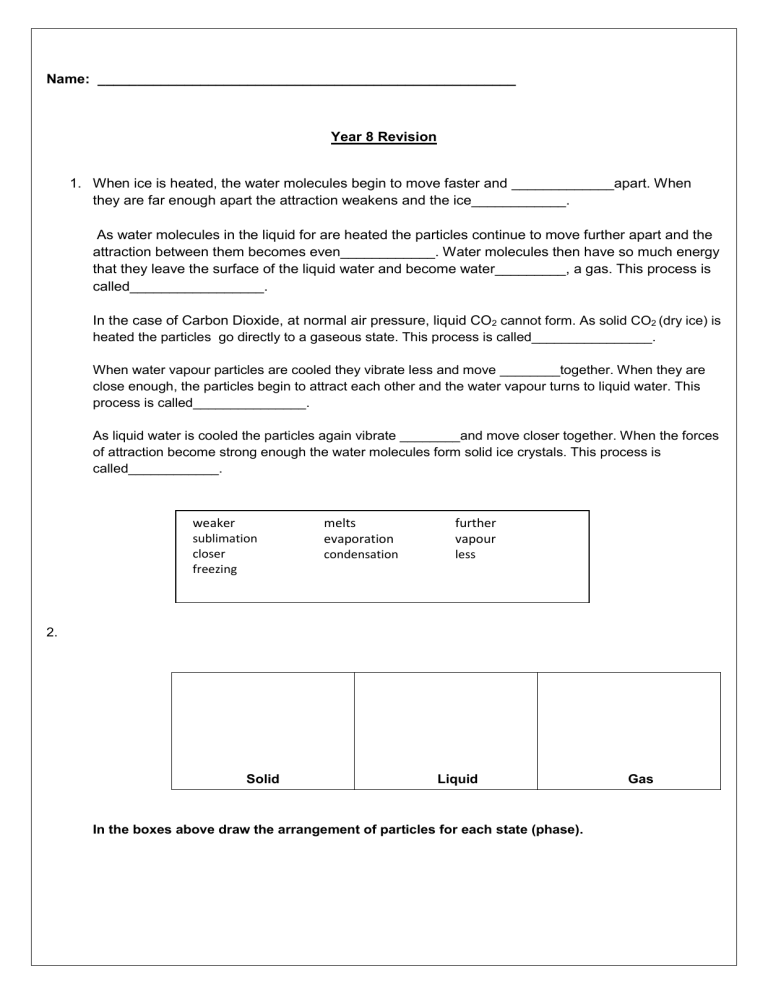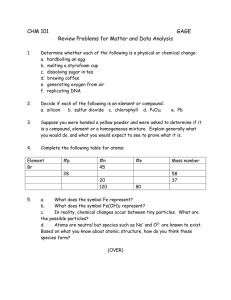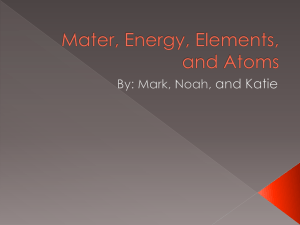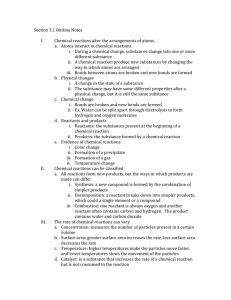
Name: _____________________________________________________ Year 8 Revision 1. When ice is heated, the water molecules begin to move faster and _____________apart. When they are far enough apart the attraction weakens and the ice____________. As water molecules in the liquid for are heated the particles continue to move further apart and the attraction between them becomes even____________. Water molecules then have so much energy that they leave the surface of the liquid water and become water_________, a gas. This process is called_________________. In the case of Carbon Dioxide, at normal air pressure, liquid CO2 cannot form. As solid CO2 (dry ice) is heated the particles go directly to a gaseous state. This process is called________________. When water vapour particles are cooled they vibrate less and move ________together. When they are close enough, the particles begin to attract each other and the water vapour turns to liquid water. This process is called_______________. As liquid water is cooled the particles again vibrate ________and move closer together. When the forces of attraction become strong enough the water molecules form solid ice crystals. This process is called____________. weaker sublimation closer freezing melts evaporation condensation further vapour less 2. Solid Liquid In the boxes above draw the arrangement of particles for each state (phase). Gas 3. For each of the following, state whether they are an element or compound. Al ____________________ CO2 _____________________________ Be _________________________ NaCl _________________ Au____________________ C ___________________________ Explain how you made your decision as to whether a chemical formula is for an element or compound. _____________________________________________________________________________ _____________________________________________________________________________ _____________________________________________________________________________ 4. List 3 signs of a chemical change. _______________________________ ______________________________ ______________________________ 5. Give 3 examples of a physical change. _______________________________ _______________________________ _______________________________ 6. Which state(s) of matter are unable to be compressed? _____________________________________________________________________________ 7. What is the difference between compounds and mixtures? Give an example of each. _____________________________________________________________________________ 8. Particles move the fastest in which state of matter? _____________________________________________________________________________ 9. The word “flow” can be applied to which states of matter? Justify your decision. _____________________________________________________________________________ _____________________________________________________________________________ 10. True or False: Particles are always moving in a gas but stationery in a solid. _____________________________________________________________________________ 11. Define the term precipitate. _____________________________________________________________________________ 12. Contrast the terms endothermic and exothermic and give examples of each. _____________________________________________________________________________ 13. In which states of matter does diffusion occur? _____________________________________________________________________________ 14. Why do substances expand when they are heated? _____________________________________________________________________________ 15. Give an example of how the expansion of solids is used in the world around us. _____________________________________________________________________________ 17. What would happen to a balloon if you put it in the freezer? Why?. _____________________________________________________________________________ MULTIPLE CHOICE QUESTIONS 1. An element is: A an incredibly small particle, too small to be seen with a normal microscope B a substance that can be chemically broken down into simpler substances C a building block of all matter D a substance that cannot be chemically broken down into any simpler substances 2. The periodic table is organised into: A rows of elements with similar properties, increasing in atomic size down the columns B columns of elements with similar properties, increasing in atomic size down the columns C metals on the right and non-metals on the left D no specific pattern other than increasing atomic size 3. Water, H2O, is: A a compound because it cannot be broken down into simpler substances B an element because it cannot be broken down into simpler substances C a compound because it can be broken down into simpler substances D an element because it can be broken down into simpler substances 4. Alloys A include: brass, stainless steel, solder B galvanising and coating are all the same C galvanising and coating are all ways to minimise physical changes D all of above 5. In a chemical reaction: A Atoms in molecules rearrange to form new molecules. B Some atoms are lost. C Some new atoms are added. D Energy is ALWAYS given off. 6. In a chemical reaction between elements: A the atoms in the elements are rearranged to form a new substance called a compound B some reactant matter is always lost C some product matter is always created D the compound product always has the same properties as the elements 7. A glucose molecule C6H12O6 is made up of the following: A Twelve cobalt atom, six hydrogen atoms and six oxygen atom B Six carbon atoms, twelve hydrogen atoms and six oxygen atoms C One carbon atom, two hydrogen atoms and one oxygen atom D Six copper atoms, twelve hydrogen atoms and six oxygen atoms 8. Which scenario described below indicates a physical change has occurred in a substance? a) A bowl of water is placed in the freezer. b) Bacon and eggs are cooked for breakfast. c) Glow sticks are snapped, shaken slightly and then begin to glow. d) While out camping, wood is lit in a campfire and is used for cooking. 9. Which one of the following combinations of terms defines the changes of state between solids and liquids? a) Sublimation and deposition b) Evaporation and condensation c) Melting and freezing d) Distillation and condensation 10. Which one of the following combination of terms defines the changes of state between solids and gases? a) Sublimation and deposition b) Evaporation and condensation c) Melting and freezing d) Distillation and condensation 11. When a water jug is placed in a refrigerator, the liquid in the container is cooled. During this process the particles in the liquid: a) move to the bottom of the jug b) lose their energy and move more slowly c) have cold energy added to them d) get smaller and smaller.





